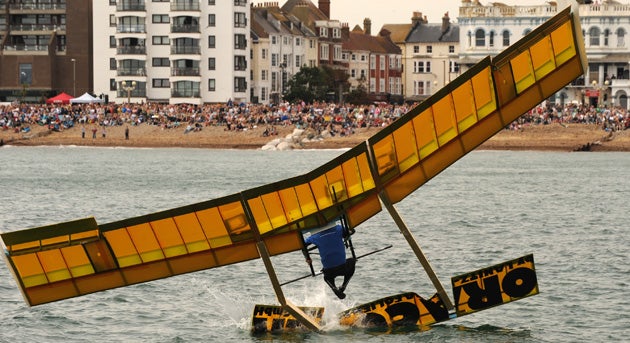Those industrious men and their flying machines
The Royal Aeronautical Society normally debates loftier issues, but will today discuss human-powered flight

Three thousand years have passed since the birth of the myth of Icarus, the man who fell into the drink off Crete when he ruined his wings of wax and feathers after flying too close to the sun. Perhaps it was that tale of death that kept us grounded before the combustion engine revived our dreams of flight – and it was left to superheroes with capes to keep the myth of Icarus alive.
But in garages and sheds up and down Britain, men – it is nearly always men – bearing tools and the belief they can fly are looking to the skies again. This eccentric breed of modern-day birdman does not flap his wings anywhere near the sun but does manage to soar several metres above the ground with no other assistance than his own ingenuity – and pedal power.
Human-powered aircraft, or HPAs, look like slender, futuristic gliders with propellers. In effect, they are fragile flying bicycles that weigh only half as much as the pilot. David Barford has never seen an HPA fly but has devoted much of his time away from his job as a racing car engineer to building his own dream machine.
Mr Barford lives, appropriately, on Hobby Close in Northampton, and, despite devoting most of his weekends and evenings to his project, says his family back him all the way: "My wife lets me store rudders and elevators in the bedroom," he says. This is the culmination of a 30-year dream for the 41-year-old, which began when he heard about the breakthrough flight of the Gossamer Condor, one of the earliest successful HPAs. "Eight years ago I built a 10-metre pterodactyl for an end-of-the-pier flying contest," Mr Barford says. "It didn't go far but it showed what you can do in a garage. It was then that I took the plunge and started work on a much better plane, with a 22-metre wingspan."
Today he will travel to London, to speak at the Royal Aeronautical Society, a prestigious body usually concerned with space-flight and convential aviation, which is hosting a special conference for enthusiasts of human-powered flight.
Fred To, another "birdman" going to the conference, is an architect keen to explore the commercial possibilities of solar-powered flight. He has built the Phoenix, an inflatable craft with a giant, 30-metre wingspan which, when deflated, can be strapped to the roof-rack of his Vauxhall Cavalier. "I only ever managed a short run of about a minute in my aeroplane," he says. "But to fly at even 8mph is a fantastic sensation." Mr To, who also lives in Northampton, believes that races using hi-tech carbon-fibre crafts could make a popular Olympic sport. He plans to demonstrate the idea near London around the time of the 2012 Games.
After Icarus, it was not until 1961 that Derek Piggott, who will also be at the conference today, powered the Southampton University Man Powered Aircraft in the first authenticated take-off and landing for a human-propelled plane. A second aerial milestone – 22 miles, in fact – followed, in 1979, when the Gossamer Albatross, a sister craft to the Condor, fluttered across the English Channel.
Nine years later, the American-built Daedalus 88 recreated Icarus's legendary flight, named as it was after the Greek character's father, with a record-breaking 74-mile journey from Crete to Santorini. This feat won a Kremer prize – one of the awards administered by the Royal Aeronautical Society which are the Holy Grail of self-propelled flight. There are thought to be just two craft with a hope of winning the £50,000 prize for the first plane to complete a marathon distance over a figure-of-eight course.
The extreme fragility of HPAs mean they can fly only in light winds. Unlike powered craft, they are a long way from being functional. As Mr Barford points out: "I can never see anyone nipping to the shops in one." In the meantime, his half-built machine is not expected to ruffle feathers in the growing HPA community. "If I take off and fly 100 metres at a height of one metre, the last six years will be worthwhile," he says.
Join our commenting forum
Join thought-provoking conversations, follow other Independent readers and see their replies
Comments
Bookmark popover
Removed from bookmarks